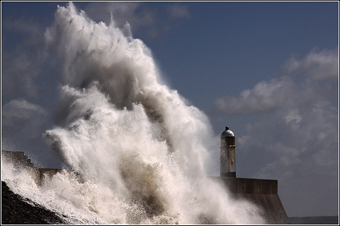Utility-Scale Wave Power, Thanks to U.S. Navy
 Ocean waves could soon be powering thousands of homes and businesses in the Reedsport, Oregon area, and a good part of the credit will be due to the U.S. Navy. The Ocean Power Technologies technology, called PowerBuoy(r), underwent two years of development at the Navy’s wave power test facility in Hawaii, and this is just the beginning. The Navy recently announced that it will be upgrading and expanding the site to provide more opportunities for innovators to test commercial-scale wave power devices.
Ocean waves could soon be powering thousands of homes and businesses in the Reedsport, Oregon area, and a good part of the credit will be due to the U.S. Navy. The Ocean Power Technologies technology, called PowerBuoy(r), underwent two years of development at the Navy’s wave power test facility in Hawaii, and this is just the beginning. The Navy recently announced that it will be upgrading and expanding the site to provide more opportunities for innovators to test commercial-scale wave power devices.Power from Waves
Ocean Power calls its utility-scale version of the PowerBuoy the PB150. As the buoy bobs up and down on offshore waves, it produces a mechanical stroking motion. That movement is transferred to a “power take-off” unit that drives an on-board generator. The resulting electrical power gets transmitted to shore by cable.
In this latest step along the way to deployment, Ocean Power has completed factory testing off the take-off unit, and it is being installed into the buoy.
The take-off unit represents a step up from the company’s initial efforts. It is scaled up from earlier versions, and its direct drive system has greater efficiency compared to a hydraulic drive that was used in the first PowerBuoy designs.
Thanks for the Wave Power, U.S. Navy
When Ocean Power began testing the PowerBuoy a couple of years ago, the device served as the country’s first grid-connected wave energy system. It provided electricity to Marine Corps Base Hawaii in Oahu.
The Navy’s wave power test site, at Kaneohe Bay, actually dates back to the Bush Administration as part of the Navy’s long term partnership with the University of Hawaii’s National Marine Renewable Energy Center.
The new test site upgrade will enable wave power companies to test larger buoys, which can be positioned at greater depths.
It’s also worth noting that DARPA, the Pentagon’s cutting-edge research agency, has been funding research into wave power, though its main focus is on small-scale devices that would be used to provide power for surveillance buoys and other remote devices.
Wave Power and Green Jobs
Take a look at some of the economic activity surrounding the outfitting of the PB150, and you’ll get a glimpse at the potential for wave power to create new green jobs in shipping, manufacturing and deployment.
The power take-off unit is being transported from the company’s New Jersey facility to Oregon Iron Works, which will connect it to the buoy’s spar. After that, the spar goes to another Oregon company, Vigor Marine, for final assembly and testing of the buoy.
Vigor Marine will also oversee launch of the buoy, and then it will be towed from the company’s Portland docks to a staging area at Reedsport/Coos Bay. Several other local companies will be involved in final deployment and connection, including the marine contractor Northwest Underwater Construction and the Knutson Towboat Company.
The PB150 will be ready for deployment late this summer, and then a period of shakeout and testing will follow. If all goes well, Ocean Power anticipates that it will eventually launch a string of PB150’s to bob among the waves.
You can return to the main Market News page, or press the Back button on your browser.

